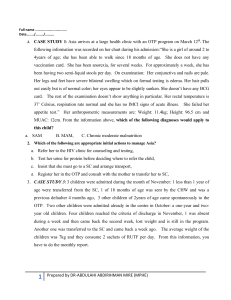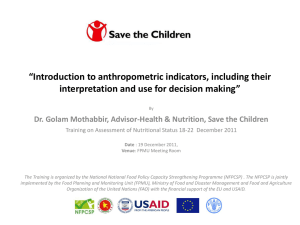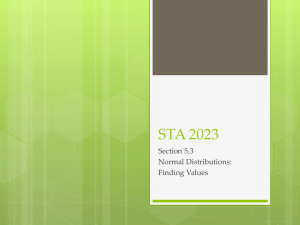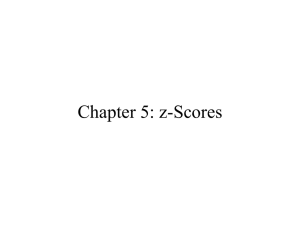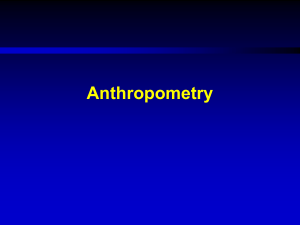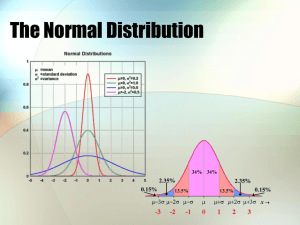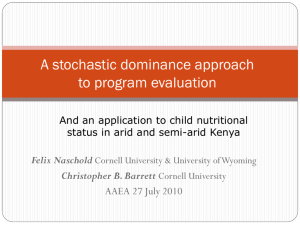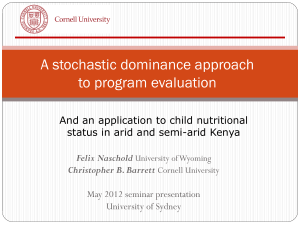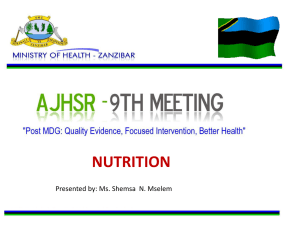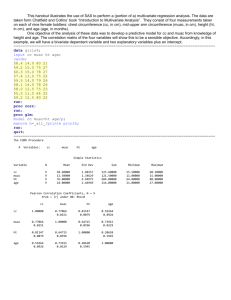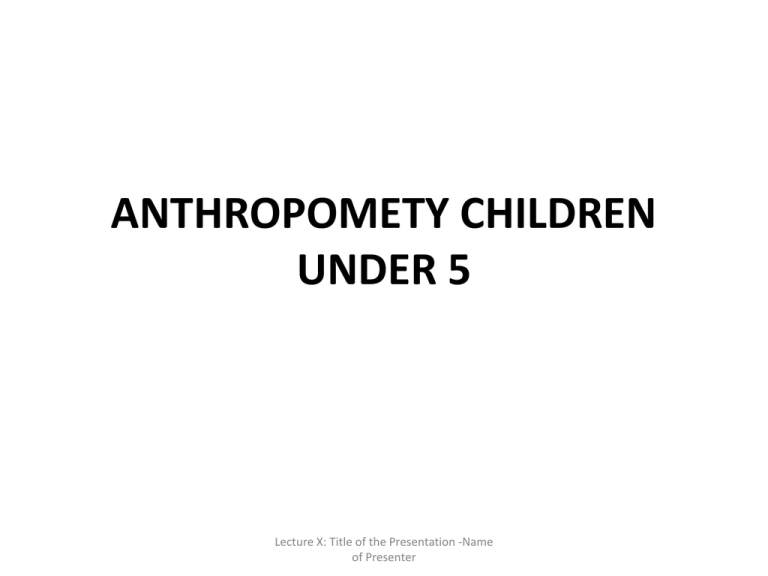
ANTHROPOMETY CHILDREN
UNDER 5
Lecture X: Title of the Presentation -Name
of Presenter
INTRODUCTION : ANTHROPOMETY CHILDREN
UNDER 5
• ANTHROPOMETRY is the measurement of the human body.
• Anthropometric measures are used to assess the nutritional status of
individuals and population groups, and as eligibility criteria for nutrition
support programs. Common anthropometric measures are
– Height,
– Weight and
– Mid-upper arm circumference (MUAC)
INTRODUCTION: ANTHROPOMETRIC INDICES
• When body measurements are compared to a reference
value, they are called nutrition indices
• Nutrition indices include
– height-for-age (HFA),
– weight-for-age (WFA),
– weight-for-height (WFH), and
– MUAC-for-age.
INTRODUCTION: NUTRITION INDICATORS
• Nutrition indicators are an interpretation of nutrition indices based on
cutoff points
– Nutrition indicators measure the clinical phenomena of malnutrition and are
used for making a judgment or assessment
– a good nutrition indicators detects as many people at risk as possible
(sensitivity) without including too many people who are not at risk (specificity)
– A good nutrition indicator should also be functionally meaningful (i.e. related
to risk of morbidity and mortality), and be sensitive to change
– Standard cutoff points are used internationally to define undernutrition in
children 6-59 months.
– The cutoff points for nutrition indicators are derived from the WHO child
growth standard population (WHO standards) or NCHS reference population
(NCHS population).
OVERVIEW OF METHODOLOGY: BUILDING
BLOCKS OF ANTHROPOMETRY
The commonly used building blocks or measures used to undertake
anthropometric assessment are:
1) Sex
2) Age
3) Weight
4) Length or Height
5) Mid-upper-arm Circumference (MUAC)
•
•
•
•
Each provides one piece of information
When used together they can provide important information about a
person’s nutritional status
When > 2 of these variables are used together they are called an index
These indices are commonly used: WA, HA & WH.
OVERVIEW OF METHODOLOGY: AGE
DETERMINATION
• Age determination is required for
– Sampling
– Deciding on whether the child is measured
standing or reclining for height or length
– Converting height and weight into the standard
indices
OVERVIEW OF METHODOLOGY: WEIGHT
MEASUREMENT
• Body weight indicates combined mass of all body
compartments (fat, fat-free mass, water, skeleton)
• Spring scales are the most common scale available
• Whatever equipment is chosen, staff needs training to ensure
its proper use & care
• Regular validation of the weighting scale is very important.
OVERVIEW OF METHODOLOGY: WEIGHT
MEASUREMENT
• Salter Scale for weighing infants & young
Children
• Can Measure up to 25 kg
• Accuracy 100 gm
Anthropometric indications measurement guide
FANTA, 2003
OVERVIEW OF METHODOLOGY:
LENGTH/HEIGHT MEASUREMENT
• Length/height indicates linear growth
• A measuring board should be lightweight, durable and have few moving
parts
• Length/height boards should be designed to measure children under 2
years of age lying down (recumbent) and older children standing up
• Several types of length and height boards are available
• Adequate training both in using the equipment and in providing
appropriate information for the caregivers.
OVERVIEW OF METHODOLOGY: LENGTH
MEASUREMENT USING LENGTH BOARD
Children under 2 yrs
• <85 cm tall
• Too ill to stand
• Accuracy 0.1 cm
Measuring length requires experience & patience
Anthropometric indicators measurement
guide FANTA.2003
OVERVIEW OF METHODOLOGY: HEIGHT
MEASUREMENT USING HEIGHT BOARD
•
•
•
Children > 2 yrs
> 85 cm tall
Accuracy 0.1 cm
Length may be up to 0.5 cm more than corresponding height
Anthropometric indicators Measurement
guide FANTA, 2003
OVERVIEW OF METHODOLOGY: MUAC
MEASUREMENT
• Is relatively easy to measure
• Use for rapid screening of acute malnutrition from the 6-59 months age
range
• A good predictor of immediate risk of death
• MUAC is also recommended for assessing adult undernutrition and for
estimating prevalence of undernutrition at the population level
• Color coded and or graduated MUAC tapes are available
Lecture X: Title of the Presentation -Name
of Presenter
OVERVIEW OF METHODOLOGY: MUAC
MEASUREMENT
• 6 mo – 5 yrs
• < 12.5 cm acute malnutrition
Anthropometric indicators Measurement
guide FANTA, 2003
Lecture X: Title of the Presentation -Name
of Presenter
OVERVIEW OF METHODOLOGY:
Indices reflect about the nutritional status of infants & children
Weight for-age:
- Low WFA identifies underweight, for a specific age & sex
- Reflects both past (chronic) &/or present (acute) undernutrition
- Unable to distinguish between the two
Height for-age:
- Low HFA identifies past or chronic undernutrition (stunting)
- Stunting indicates reduced linear growth
- Cannot measure short-term changes in malnutrition
- For children <2 yrs of age, the term is length-for-age/LA
- For children > 2 yrs age, the index is referred as height-for-age/HA
Lecture X: Title of the Presentation -Name
of Presenter
OVERVIEW OF METHODOLOGY:
Indices reflect about the nutritional status of infants & children
Weight for-height:
- Low WFH identifies current or acute undernutrition (wasting)
- Useful when exact age is difficult to determine
- Weight for-length (< 2 yrs) or weight for-height (in > 2 yrs)
- Appropriate for examining short-term effects
Mid- Upper Arm Circumference (MUAC):
- Low MUAC (<12.5 cm) indicates acute malnutrition among children 659 months
- Is relatively easy to measure and a good predictor of immediate risk of
death
- Is used for rapid screening of acute malnutrition
Lecture X: Title of the Presentation -Name
of Presenter
OVERVIEW OF METHODOLOGY: USE OF
NUTRITION INDICES
Measure or
Index
WFA
HFA
Nutritional Condition
UNDERWEIGHT ( composite
measure of stunting and wasting)
To assess changes in the magnitude of
malnutrition over time
STUNTING (Past growth failure;
•
associated with a number of long-term
factors including chronic insufficient
protein and energy intake, frequent
infection, sustained inappropriate
feeding practices and poverty etc.)
WFH
Usefulness of Index
•
•
Problem analysis in designing
interventions
Evaluation of program preferably for
children under 2 years of age
not for monitoring as it does not change in the
short term such as 6-12 months
WASTING ( current or acute
• Screening or targeting purposes as
malnutrition resulting from failure to gain
weight or weight loss. Causes includes
inadequate food intake, incorrect feeding
practices, disease, and infection or, more
frequently, a combination of these
factors.)
wasting in individual children and population
groups can change rapidly and shows marked
seasonal patterns associated with changes in food
availability or disease prevalence to which it is very
sensitive.
• Annual reporting
Lecture X: Title of the Presentation -Name
of Presenter
OVERVIEW OF METHODOLOGY: USE OF
NUTRITION INDICES
Measure or
Index
Nutritional Condition
Usefulness of Index
MUAC
WASTING
• Rapid screening of acute malnutrition from
the 6-59 month age range
• Assessing acute adult undernutrition and
• Estimating prevalence of undernutrition at
the population level
Odema
(presence of
excessive
amounts of fluid
in the
intracellular
tissue)
Clinical sign of severe malnutrition
•
Screening and Surveillance
Lecture X: Title of the Presentation -Name
of Presenter
OVERVIEW OF METHODOLOGY: REFERENCES
• To standardize a child’s measurement to compare individual
value with the median/mean of same age & sex
• Taking age & sex into consideration, difference in
measurements can be expressed as:
- standard deviation (SD) or Z-score
- percentage of the median
- percentile (least useful in clinical practice)
[Z-score is preferable; percentage may be used ]
Lecture X: Title of the Presentation -Name
of Presenter
OVERVIEW OF METHODOLOGY: SD Score or ZScore
• A SD score is also called a Z-score and is defined as the deviation of an
observed individual value from the median value of the reference
population.
• A Z-score is the number of standard deviations (SD) below or above the
reference median value (WHO/UNICEF definition, 2009).
The median is the middle value in a set of values. It is one type of ‘average’
• The Z-score or standard deviation unit (SD) is defined as the difference
between the value for an individual and the median value of the reference
population for the same age or height, divided by the standard deviation of
the reference population. This can be written in equation form as:
Z-score (or SD-score) =
(observed value) – (median reference Value)
standard deviation of reference population
Lecture X: Title of the Presentation -Name
of Presenter
OVERVIEW OF METHODOLOGY: SD Score or ZScore
•
•
•
•
Z-score can be used to indicate how far a child’s weight is from the median weight
for that child’s height (the standard deviation or SD)
The concept of a normal distribution is important for understanding what a Z-score
is. In a normal distribution, most values are grouped around the middle, or
“normal”
A Z-score gives an image of how far a child is from “normal” or the median
The weights of all boys or all girls of a certain height fall into a normal (or almost
normal) distribution. When the weights are graphed, the result resembles a normal
bell-shaped curve.
+
+
+
Lecture X: Title of the Presentation -Name
of Presenter
OVERVIEW OF METHODOLOGY: SD Score or ZScore
• Z-scores are more commonly used by the international nutrition
community because they offer two major advantages
• First , using Z-scores allow us to identify a fixed point in the
distribution of different indices and across different ages
• The second major advantage of using Z-scores is that useful
summary statistics can be calculated from them; mean and
standard deviation to be calculated for the Z-scores for a group of
children.
Lecture X: Title of the Presentation -Name
of Presenter
OVERVIEW OF METHODOLOGY: REFERENCES
•
The median is the value at exactly the midpoint between the largest and smallest. The
percentage of the median is defined as the ratio of a measured or observed value in the
individual to the median value of the reference data for the same age or height for the specific
sex, expressed as a percentage. This can be written in equation form as:
Percent of median =
observed value
x 100
median value of reference population
•
The percentile is the rank position of an individual on a given reference distribution, stated in
terms of what percentage of the group the individual equals or exceeds.
OVERVIEW OF METHODOLOGY: SD Score or ZScore
• A comparison of cutoffs for percent of median, percentile and Z-scores
illustrates the following:
Z-score
Percent of median
Percentile
-3
70%
0.13
-2
80%
2.28
-1
90%
15.8
OVERVIEW OF METHODOLOGY: REFERENCE
STANDARD
Bangladesh has adopted the new World Health
Organization (WHO) Growth Reference Standard (GRS),
Which should be used for determining the WHM and
WHZ.
OVERVIEW OF METHODOLOGY: TYPES OF
UNDERNTURITION
• Undernutrition is defined as lack of nutrients caused by
inadequate dietary intake and/or disease. It compasses
a range of conditions, including
–
–
–
–
Acute malnutrition
Chronic malnutrition
Underweight
Micronutrient deficiency
• Undernutrition is defined based on anthropometric
indicators, clinical signs and clinical tests.
OVERVIEW OF METHODOLOGY: Different forms of
undernutrition
Definition
INDEX or
MEASURE
MODERATE
SEVERE
HFA
<-2 and > -3
z-score
<-3 z-score
WFH
<-2 and > -3
z-score
<-3 z-score
MUAC
(6-59 months)
<125 mm and >
115 mm
<115 mm
MUAC
(6-59 months)
<-2 and > -3
z-score
<-3 z-score
WFA
<-2 and > -3
z-score
<-3 z-score
Stunting reflects chronic malnutrition
Inadequate length or height* relative to age
Wasting reflects acute malnutrition
Inadequate weight relative to length or height*
Inadequate muscle tissue and fat stores in the body
Underweight reflects both chronic and acute
malnutrition.
Inadequate weight relative to age
Bilateral Pitting Oedema reflects severe acute malnutrition
An accumulation of fluid that starts in both feet and that can progress
to other parts of the body
Any bilateral pitting oedema indicates
severe acute malnutrition
OVERVIEW OF METHODOLOGY : ACUTE
MALNUTRITION
• Acute malnutrition caused by a decrease in food
consumption and/or illness resulting in bilateral
pitting oedema or sudden weight loss.
• It is defined by the presence of bilateral pitting
oedema or by wasting
OVERVIEW OF METHODOLOGY: Types of Acute
Malnutrition
Severe Acute
Malnutrition (SAM)
• is defined by the presence
of bilateral pitting or severe
wasting
• a child with SAM is highly
vulnerable and has a high
mortality rate
Moderate Acute
Malnutrition (MAM)
• is defined by moderate
wasting
Overview of Methodology : Reference Cutoff
Values for SAM & MAM
Bilateral pitting MUAC
oedema
WFH z-score (WHO
standards or NCHS
references)
WFH as a
percentage of the
median (NCHS
references)
SAM :
Present
<115 mm or
red
<-3
<70%
MAM :
Not present
>110 mm and
<125 mm
or yellow
> -3 and <-2
> 70% and <80%
METHODS OF DATA COLLECTION
• Community level screening e.g. GMP
• Household visits
• Survey
METHODS OF DATA ANALYSIS
• Use computer software like e.g. Epi Info,
ANTHRO, SPSS etc.
–
–
–
–
–
–
–
Prevalence of malnutrition
Recovery rate
Death rate
Defaulter rate
Non-responder rate
Average length of stay
Average weight gain per kg/day
VALIDITY AND RELIABILITY : WHO child growth standards and the
identification of severe acute malnutrition in infants and children
Using weight-for-height
•
•
WHO and UNICEF recommend the use of a cut-off for weight-for height of below 3 standard deviations (SD) of the WHO standards to identify infants and children as
having SAM.
The commonly used cut-off is the same cut-off for both the new 2006 WHO child
growth standards (WHO standards) as with the earlier National Center for Health
Statistics (NCHS reference). The reasons for the choice of this cut-off are as
follows:
1)
2)
3)
4)
Children below this cut-off have a highly elevated risk of death compared to those who are
above;
These children have a higher weight gain when receiving a therapeutic diet compared to
other diets, which results in faster recovery;
In a well-nourished population there are virtually no children below -3 SD (<1%).
There are no known risks or negative effects associated with therapeutic feeding of these
children applying recommended protocols and appropriate therapeutic foods.
VALIDITY AND RELIABILITY : WHO child growth standards and the
identification of severe acute malnutrition in infants and children
Using MUAC
•
•
•
•
•
WHO standards for mid-upper arm circumference (MUAC)-for-age show that in a
well nourished population there are very few children aged 6–60 months with a
MUAC less than 115 mm. Children with a MUAC less than 115 mm have a highly
elevated risk of death compared to those who are above.
Thus it is recommended to increase the cut-off point from 110 to 115 mm to
define SAM with MUAC.
When using the WHO child growth standards to identify the severely
malnourished among 6–60 month old children, the below -3SD cut-off for weightfor-height classifies two to four times as many children compared with the NCHS
reference.
The prevalence of SAM, i.e. numbers of children with SAM, based on weight-for
height below -3 SD of the WHO standards and those based on a MUAC cut-off of
115 mm, are very similar.
The shift from NCHS to WHO child growth standards or the adoption of the new
cut-off for MUAC will therefore sharply increase case loads. This has programmatic
implications.
Conclusion
• Advantages of anthropometry
Simple, safe, cheap, non-invasive, portable
requires minimal training
• Limitations of anthropometry
Cannot identify specific deficiencies, fairly slow to
respond to recent changes in nutritional status
Conclusion
USE OF ANTHROPOEMETRY
• Identify individuals & populations with normal & abnormal
nutritional status
• Predict who will benefit from interventions
• Identify social & economic inequity
• Evaluate response to interventions.
Lecture X: Title of the Presentation -Name of Presenter
Thank You
Lecture X: Title of the Presentation -Name
of Presenter

